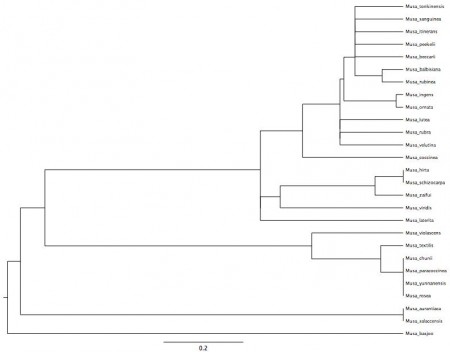- Genomics reveals new landscapes for crop improvement. Which are dominated by the looming presence of Mount Phenotyping.
- Where Have All the Crop Phenotypes Gone? Someone mention phenotyping?
- Smallholder agricultural commercialization for income growth and poverty alleviation in southern Africa: A review. On balance, it’s a good thing.
- Genetic diversity of yacon (Smallanthus sonchifolius (Poepp. & Endl.) H. Robinson) and its wild relatives as revealed by ISSR markers. Low diversity among the cultivated stuff, which is quite distinct from the wilds. All due to clonal propagation. No concrete recommendations apart from conserving all you can find. Pity.
- Molecular Genetic Diversity of Major Indian Rice Cultivars over Decadal Periods. Genetic diversity among high yielding varieties released in India went up between 1970 and 2010.
- Ten principles for a landscape approach to reconciling agriculture, conservation, and other competing land uses. Adapt, involve, multitask. And more, much more, from Mongbay.
- Uncertainty, ignorance and ambiguity in crop modelling for African agricultural adaptation. Be open about assumptions, communicate with and involve diverse stakeholders in appropriate ways, accept feedback from policy-makers. Could be talking about GMOs. Or the above.
- The effect of rising food prices on food consumption: systematic review with meta-regression. Worse for poorer countries, and worse for poorer households in all countries.
Is this automated Musa phylogeny any good?
PhyloGenerator is “an open-source, stand-alone Python program, that makes use of pre-existing sequence data and taxonomic information to largely automate the estimation of phylogenies.” Sounds intriguing, no? I found out about it via this Twitter exchange with Rich Grenyer:
@rich_ @Phalaropus Sure, of course!
— AgroBioDiverse (@AgroBioDiverse) July 11, 2013
He very kindly shared his automatically generated Musa phylogeny, which is reproduced below. I’m afraid you’ll have to click on the image to read the species names.
So now I’m reaching out to all you banana taxonomists out there. Does this make any sense?
Nibbles: Tree ID, Pyramid scheme, Looking ahead, Fun with mould, GM wheat, Sinai reclaimed
Stuff that’s been sitting around while I’ve been lying on a beach:
- Speaking of apps for agriculture, here’s one that identifies North American trees.
- R. Ford Denison spots the weakness in an afro-forestry get-rich-quick scheme.
- Public Radio International has a big series on feeding the 9 billion — and wants photos of your lunch.
- I’ve no idea why people are squeamish about smut. Huitlacoche is my personal favourite among Smithsonian MAG’s Four Fungi Fit For Your Plate.
- No idea what’s happened lately to Monsanto’s GM wheat fiasco. Is the US National Center for Genetic Resources Preservation off the hook?
- And something old yet new: reclaiming the Sinai for agriculture by reviving an ancient river.
Nibbles: CePaCT aroids, Chinese pigs, Vanuatu banana processing, Yam meeting, AAB meeting, Araucaria, Aquaculture, Malting barley, CIRAD baobab videos, US wine, Ancient grains, Barcode centre
- The Pacific pushes out its taros.
- China holds on to its pigs.
- Vanuatu preserves its bananas.
- The world talks about yams in particular. And crop breeding in general.
- How Britain got its monkey puzzles.
- Bangladesh goes for mola culture. But not only.
- Australia puts money into beer.
- France gets into the whole baobab factsheet thing, but with a video twist.
- Virginia makes wine. With infographic goodness.
- UK tries to slow down its food.
- Canada barcodes everything.
Brainfood: Leafy greens, Korean rice, Molecular breeding, Poultry conservation, Tree genomes, Pathogen genetics, Grazers and CC, Sustainable rangelands, Available land, Ecosystem services
- Analysis of urban consumers’ willingness to pay a premium for African Leafy Vegetables (ALVs) in Kenya: a case of Eldoret Town. An 80% premium! But in Eldoret. And Nairobi?
- Analysis and comparison of the γ-oryzanol content based on phylogenetic groups in Korean landraces of rice (Oryza sativa L.). Some groups are browner than others.
- What is the SMARTest way to breed plants and increase agrobiodiversity? Just another name for MAS. But some crops are SMARTer than others.
- Conservation of local Turkish and Italian chicken breeds: a case study. Turks can learn from Italians. And probably vice versa, I bet, although that’s not explored as much here.
- Open access to tree genomes: the path to a better forest. Hard to argue with. The open access bit more than the genomes bit.
- Evolution, selection and isolation: a genomic view of speciation in fungal plant pathogens. Know your enemy. Easier to figure out how new species become different than how they stay that way.
- Long-Term Climate Sensitivity of Grazer Performance: A Cross-Site Study. Hotter conditions means poorer forage quality means smaller bison. And maybe cattle. All other things being equal, like genetics, and range management. Which of course they never are.
- Ecosystem function enhanced by combining four functional types of plant species in intensively managed grassland mixtures: a 3-year continental-scale field experiment. See what I mean? And more.
- Estimating the world’s potentially available cropland using a bottom-up approach. Less than you’d think.
- Spatial interactions among ecosystem services in an urbanizing agricultural watershed. Very very limited places provide multiple services, especially crop production and water quality, which means you need to protect huge areas. But they’ll be mosaics.
